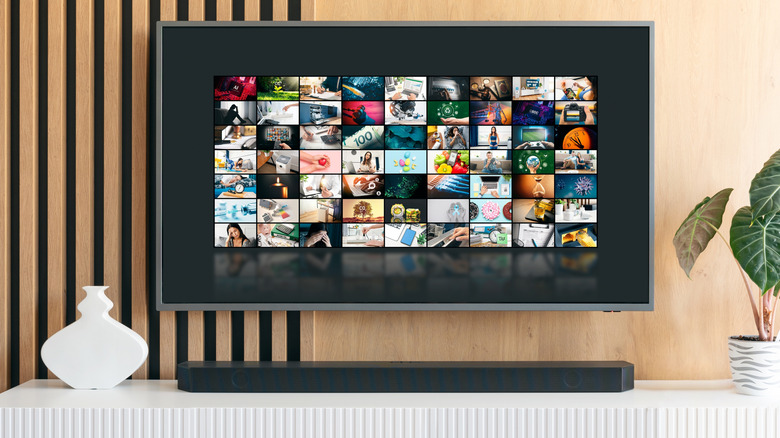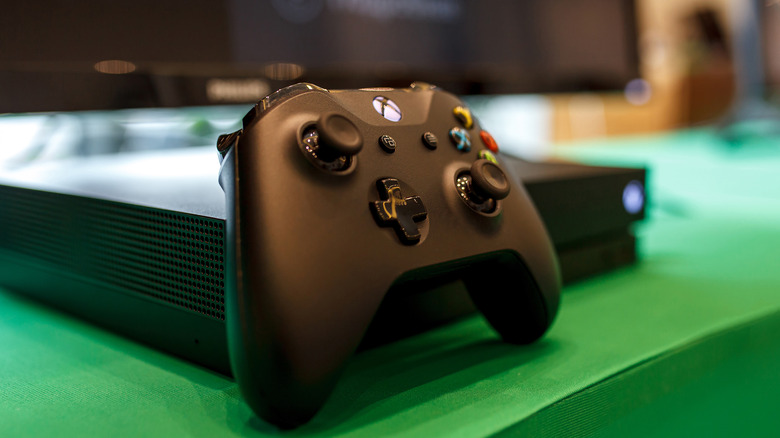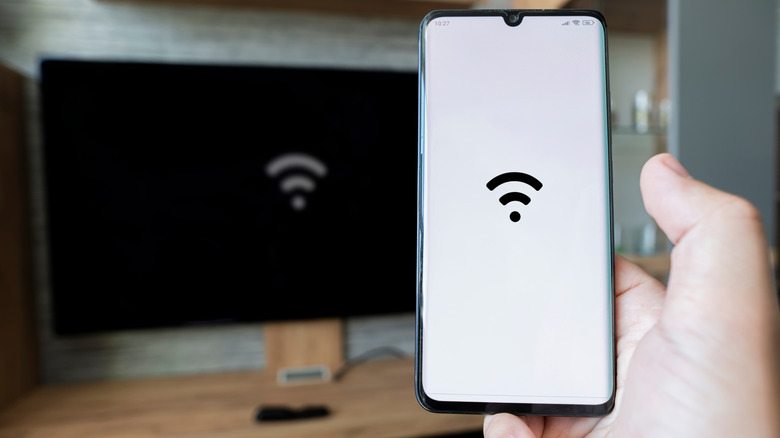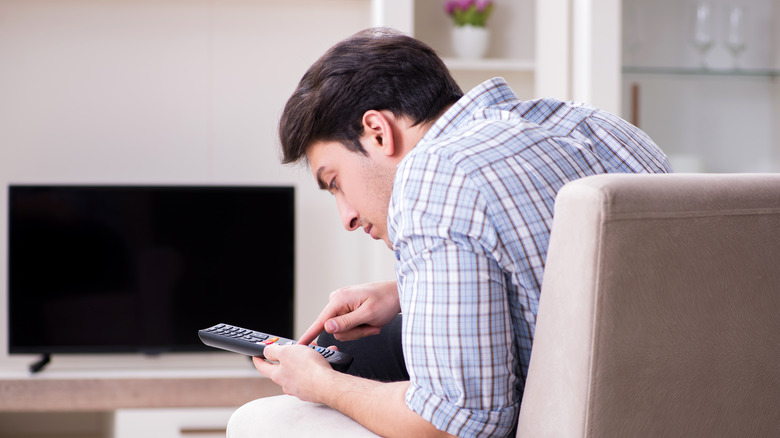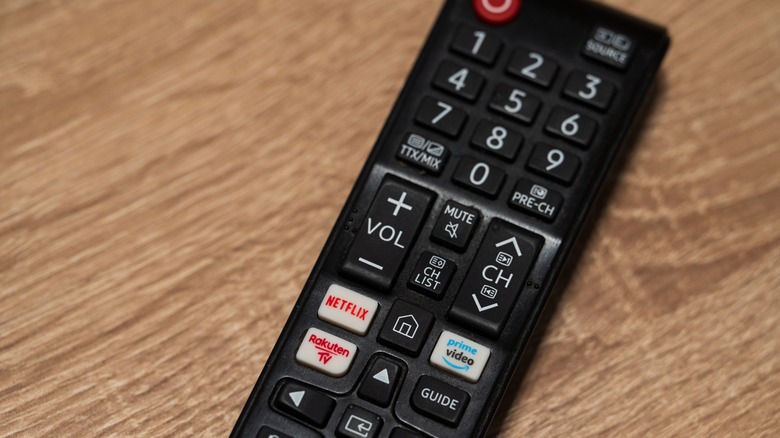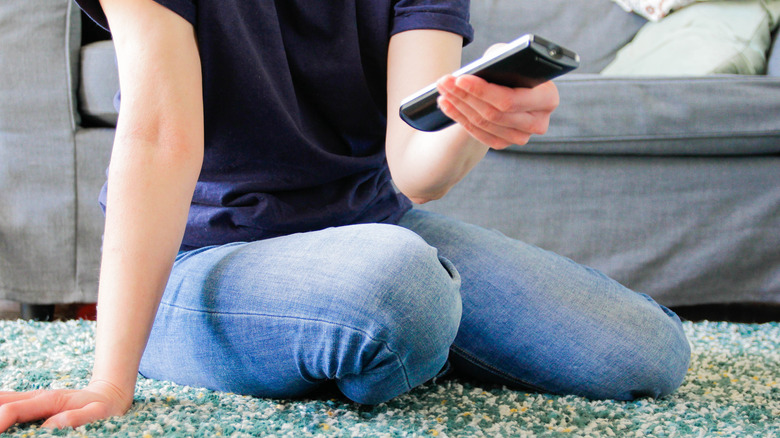6 Reasons Why Your TV Is Turning On By Itself (And How To Stop It)
Maybe it's happened to you: you're busy doing something, and all of a sudden, you hear your TV come on in another room. It can be a bit disconcerting. You know you didn't do anything to power it on, yet there it is in the background, with the screen flickering and sound coming from the speakers. Whether you own one of the highest-rated Samsung TVs or a budget-friendly model that cost less than $500, this phenomenon can happen to you — and it doesn't mean your house is haunted. Instead, you're dealing with a common problem that plagues smart TVs but is usually easy enough to fix.
Smart TVs rely on a lot of technology to work properly, including connectivity features like HDMI-CEC, Wi-Fi, and infrared signals to interact with other devices. As a result, signals can get mixed, which occasionally results in your TV turning itself on when you least expect it. Sometimes, a simple fix like changing a menu setting will be enough to stop the problem; other times, you might need to troubleshoot connected devices or update your TV's software to get things back on track.
Before you do anything else, you should try unplugging your TV, holding down the power button for ten seconds, and then plugging it back in to see if that corrects the issue. Just like with your smartphone and other devices, a quick restart is often enough to fix minor issues. If that doesn't work, don't throw it in the towel. Your TV most likely isn't broken, and there are several other things you can do to stop your TV from turning on by itself.
HDMI-CEC activation
One thing about Smart TVs is they like to talk to other connected devices. HDMI Consumer Electronics Control, better known as HDMI-CEC, is one way to make this magic happen, allowing you to control all of your HDMI-connected devices with a single remote, i.e., using your TV's remote control with your Xbox Series X|S. While there are a lot of good reasons for using HDMI-CEC, and the technology can simplify your entertainment setup, it can also cause weird things to happen, like your TV turning on unexpectedly.
Unfortunately, as convenient as HDMI-CEC can be, if it's what's causing your TV to turn on by itself, disabling it is going to be the best solution. You can do this by turning off the feature in your TV's settings menu and checking to see if that solves the problem. HDMI-CEC goes by different names depending on your TV's manufacturer; LG calls it SIMPLINK, Samsung calls it Anynet+, and Sony calls it BRAVIA Sync.
If you find that disabling HDMI-CEC solves the problem, but you still want to use the technology, you can go through a process of elimination to try to find that device that's sending the signal that's turning your TV on by disconnecting each connected device one at a time. After you've unplugged the device, check to see if the TV turns itself on again. Keep doing this until you find the problematic device.
Timer settings
If your TV seems to only turn itself on at specific times during the day, you may be dealing with a timer issue. Many modern TVs come with an internal timer that allows users to turn them on and off at a set time every day. This feature is great if you want to use your TV as an alarm clock to help you get up in the morning or you leave it on as you drift to sleep but want to make sure it doesn't stay on all night. However, if your TV is coming on when you don't want it to, you or someone who uses your TV may have unintentionally set the internal timer, causing your TV to come on at inopportune times.
You can easily check to see if this is the problem in your TV's settings menu. Where this feature is found will vary from TV to TV. For most LG TVs, go to All Settings > General > System > Time & Time > Timers. If you have a Sony TV, press the Home button and then go to Settings > Preferences > Clock/Timers > Timer > Off. Timer settings will typically be found in the settings menu of most other brands as well if they have this feature.
Wi-Fi interference
Even if you have disabled HDMI-CEC, if your TV is connected to a smart home device like Apple HomePod, Google Nest Hub, or a Logitech Harmony Hub, it may still receive commands that turn it on without you doing anything. For example, a voice command or smart routine could accidentally trigger your TV to power on, especially if it misunderstood a wake word or you have an automated schedule set up for the device.
You might also find this happens if your TV supports built-in casting; it might turn on automatically whenever you use your phone to watch a video on Netflix or another streaming service. Turning off your home's Wi-Fi will fix this problem because it stops the network-based signals that could be waking your TV, including casting requests, smart home commands, and other remote access features. If you try this and it works, you can start going through your smart apps and devices one by one to figure out which one is the culprit.
Remote control malfunction
While you may wonder how your remote control could possibly turn on your TV without you actively pressing the power, it happens more often than one would think. Our TV remotes get a lot of use, and sometimes the buttons get stuck. If that button happens to be the power button, then it can send continuous signals to your TV that might cause it to turn on when you least expect it. When this happens, it's easy to fix — just open up your remote, remove the batteries, and give it a thorough cleaning. Make sure you get between the buttons to remove any caked-in debris. Once it has dried, put the batteries back in and see if that's solved the problem.
If the batteries in your remote control are low, that can also cause it to turn on your TV unexpectedly. That's because a remote with low battery power may act unpredictably, sending random or incomplete signals to your TV and turning it on without you doing anything. A good sign your battery is low is if you have to press its buttons more than once to get it to respond. If you suspect your remote's batteries are low, change them and see if that fixes the issue.
Another TV's remote is controlling yours
Most of us have more than one TV in our homes, and our neighbors do, too. While this usually isn't a problem, sometimes, they can interfere with each other, especially if they're the same or a similar model. This problem occurs when your TV intercepts the commands from another TV's remote. You won't usually experience this issue unless the TVs aren't set up very far from each other.
One situation where this could happen is if you have Samsung TVs located throughout your home and one remote's signal reaches another TV, turning it on unintentionally. While not very common, even your neighbor's remote could interfere with your TV, especially if they're using a universal remote that is compatible with your TV. If this is happening, you can try repositioning your TV so that the infrared signals from the other remote can't reach it. Another technique is covering the TV sensor with tape or cardboard to keep the other remote's signal from reaching it. If you suspect your neighbor's TV may be to blame, ask them to test whether their remote can power on your TV.
Firmware updates
In the same way that you need to keep your smartphone's firmware up to date so that it functions as it should, your TV also needs regular software updates to fix bugs, improve performance, and prevent glitches like your TV turning itself on. You can check for firmware updates in the settings menu on your TV. If any are available, try installing them to see if that resolves the problem.
One problem with firmware updates is they can sometimes cause problems you weren't experiencing before. Whether that happens or not will often depend on your TV's age and model. That's why it's best to go through other troubleshooting steps before updating your TV's firmware. If you've done that and still can't figure out what's going on, updating your TV's software could help. While you can often do this directly through the TV's settings menu via Wi-Fi, with some TVs, you may have to manually install the update using a flash drive. If that's the case with your TV, you can check the manufacturer's website for information about updates.
